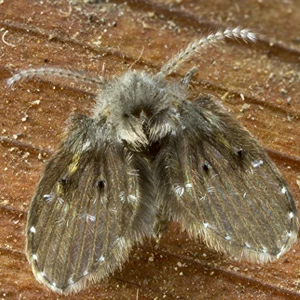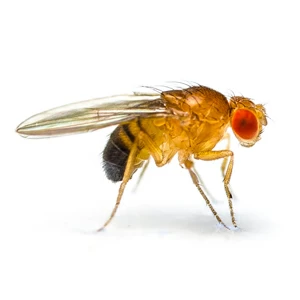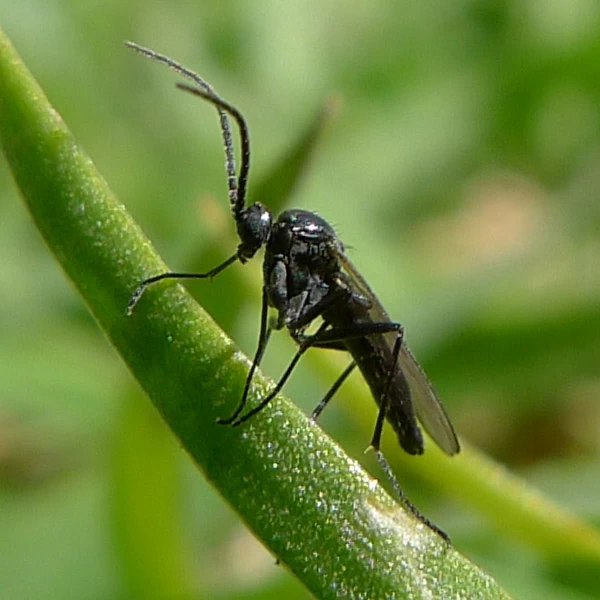


Bugging
You?
Fly Identification
There are many flies that you can encounter within your dwelling. Despite being a nuisance, many are disease vectors as well. Controlling the problem is of utmost importance to the well-being and safety of your family!

Drain Flies
Identification Tips:
- Color: Brownish-gray to blackish with a fuzzy appearance
- Legs: 6
- Size: Adults measure 1/5 to 1/6 inches long
- Identifying Characteristics: Body and wings are densely covered with hairs; antennae are long and fuzzy (13 segments); V-shaped appearance.
Characteristics of this insect:
- Fly in short, jerky movements. They are weak fliers and are seen resting or crawling on walls nearby the breeding site
- Females lay 30 to 100 eggs in irregular masses on the surface of gelatinous material or polluted, shallow water nearby or inside drain pipes. Development time from egg to adult is 7 to 28 days depending on conditions. Adults live about two weeks but are quickly replaced by others emerging into adulthood.
- Troublesome for the homeowner if present in the drain system. The drain/sewage pipe may be cracked, and these flies are breeding in moist organic matter due to water seepage.
- Most active at night. During the day, you may find them in shaded areas by plumbing fixtures or the sides of showers and tubs.

House Flies
Identification Tips:
- Color: Houseflies are mostly dull gray with four longitudinal stripes on the thorax and velvety stripes (silver above and gold below) on the face
- Legs: 6
- Size: 1/8 to 1/4 inches long
- Identifying Characteristics: Females lay eggs in clusters for 75 to 150 per batch, with 5 to 6 sets in her lifetime. Depending on conditions, egg to adult can take as little as six days
Characteristics of this insect:
- The most common fly found in the home.
- It is not only a nuisance but of great concern as a potential carrier of disease organisms.
- They are attracted to various substances, from excrement to human foods, and prefer warmer temperatures.
- On cooler days, they are attracted to warmer air being expelled from structures.

Flesh Flies
Identification Tips:
- Color: Flesh flies have three black and gray longitudinal stripes on the thorax and checkering on the abdomen.
- Legs: 6
- Size: 1/4 to 7/16 inches long
- Identifying Characteristics: Females lay 325 larvae (not eggs) during their life span and complete their life cycle in 10 to 25 days.
Characteristics of this insect:
- The name comes from the fact that the larvae develop in spoiling meat and decayed flesh.
- Because they develop in fecal matter and garbage, some species are of human health concern.
- Females give birth to larvae/maggots instead of laying eggs.
- Dead rodents, birds, and other small animals can be the source of flies within structures, while dog excrement and garbage are the standard outdoor source.

Bottle Flies
Identification Tips:
- Color: Metallic blue, green, bronze, brassy or black in whole or part.
- Legs: 6
- Size: 3/8 to 5/8 inches long
- Identifying Characteristics: Females lay about 2,300 eggs (depending on species) during their lifetime and complete their life cycle in 10 or more days.
Characteristics of this insect:
- They are of medical importance due to their mechanical transmission of disease organisms and their ability to cause an infestation of tissues/cavities in humans and animals.
- Most species develop in meat or animal carcasses.
- Dead rodents, birds, and other small animals can be the source of flies within structures, while dog excrement and garbage are the standard outdoor source.
- These flies are usually the first insects to arrive ad infest after an animal dies.

Fruit Flies
Identification Tips:
- Color: Dull brownish-yellow to brownish-black
- Legs: 6
- strong>Size: Adults measure 1/8 to 1/5 inches long
- Identifying Characteristics: Red eyes; wings have two “breaks” in the leading edge near the body; third antenna segment is oval or extended with the outer bristle nearly always feathered.
Characteristics of this insect:
- It may be seen around decaying or rotting fruits and vegetables. The inside may be seen hovering around: overripe fruit and vegetables; baked goods containing yeast; garbage cans; sweetened beverages including beer, wine, and vinegar; dirty garbage receptacles; and drain water in refrigerators or iceboxes, to name a few. Some species are attracted to human and animal excrement.
- Fruit flies lay approximately 500 eggs near fermenting fruits and vegetables. Eggs will hatch in about 30 hours.
- Newly emerged adults will mate in 2 days. The life cycle from adult to adult is 8 to 10 days at 85 degrees Fahrenheit.
- Some fruit or vinegar fly species have been responsible for human intestinal myiasis (a form of diarrhea) common among workers in grape vineyards.

Phorid Flies
Identification Tips:
- Color: It may be black, brown, or yellowish
- Legs: 6
- Size: Adults measure 1/8 to 1/4 inches long
- Identifying Characteristics: Humpbacked appearance; runs about in an erratic manner; strong, heavily pigmented veins in the front area with remaining veins faint
Characteristics of this insect:
- Females lay up to 100 eggs one at a time on, in, or close to larval food. Egg to adult depends on temperature (11 days at 85 degrees Fahrenheit and 28 days at 72 degrees Fahrenheit).
- Familiar food sources include moist residue on the bottom of trash receptacles or garbage disposals; moist material in cracks of or under kitchen equipment; drains with excessive gelatinous build-up; dirty mop heads; faulty septic tanks; over-watered/rotting plants, to mention a few.
- Troublesome for the homeowner if present in the drain system. The drain/sewage pipe may be cracked, and these flies are breeding in moist organic matter due to water seepage. They are troublesome for mortuaries, morgues, and mausoleums as they can produce in human corpses and are often referred to as coffin flies.
- Troublesome for healthcare facilities because the fly is quite unsanitary, and the larvae of this fly have been found in open wounds of patients.

Cluster Flies
Identification Tips:
- Color: Grayish with black patterns and golden hairs
- Legs: 6
- Size: 1/4 to 1/2 inches long (Slightly more prominent than the common house fly)
- Identifying Characteristics: Cluster flies are known to hibernate or “cluster” in wall voids or attics during colder months.
Characteristics of this insect:
- Cluster flies are named after their habit of grouping together like a cluster. In the winter, these flies attempt to enter your home to stay warm during the colder months. They gather near windows to seek warmth from the sun.
- Unlike other fly species, they do not breed in your home. They only stay there to seek warmth.
- Cluster flies will not damage your home nor carry any harmful diseases to humans. However, they may leave small dark-colored spots of excrement on windows and walls.
- Cluster flies can be a problem in susceptible areas such as hospitals.

Darkwing Fungus Gnat
Identification Tips:
- Color: grayish-black with smoky-colored wings
- Legs: 6
- Size: Adults grow only to be about 1/8th inch in length. The larvae are slightly larger than the adults at about 1/4 inch in length.
- Identifying Characteristics: Dark-winged fungus gnats are typically found around areas with high humidity. They tend to remain low to the ground near soil and plants. These pests can cause problems for greenhouses and mushroom growers in particular. They can be seen in other areas, such as leaky roofs, damp woodwork, compost piles, & decaying mulch.
Characteristics of this insect:
- Female fungus gnats lay eggs in soil or other damp, organic plant material. The eggs hatch into larvae. Some species of this gnat feed on fungus in overwatered soil. Some feed on plant roots. This can diminish the health of the plants and can lead to stunted growth. The gnat larvae can also carry plant pathogens which may put some plants at risk of various plant diseases.
- The larval stage typically lasts 6 to 8 days. After they pupate in the soil, adults emerge about three days later.
- The key to controlling fungus gnats is finding and eliminating all breeding sources. All potential sources must be examined with attention to damp areas supporting fungal growth. To prevent the problematic fungus gnats, one must remove moist areas that support fungal growth.
- It may be helpful to improve the ventilation, install a dehumidifier, or turn on air conditioning for indoor areas. For outdoor areas, consider turning over the top 2-3 inches of mulch or soil to speed up the drying process.
